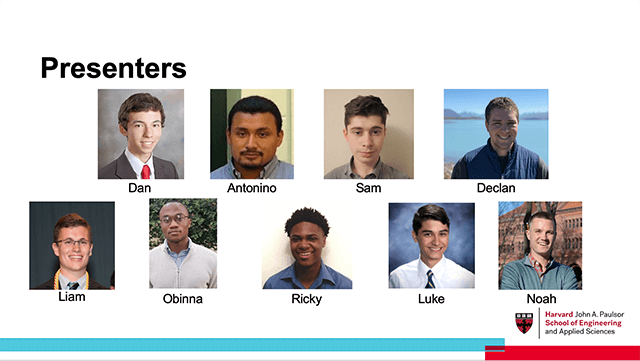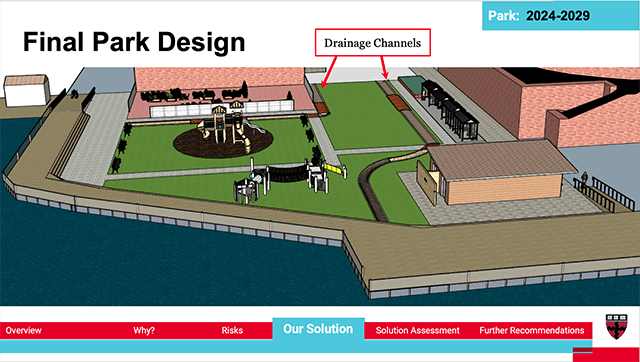News
A view of Long Wharf with downtown Boston in the background. (Chris Wood, via Wikimedia Commons)
Rising sea levels and more frequent storms pose an imminent danger to Boston’s Long Wharf, one of the city’s most popular recreation centers and tourist destinations.
The City of Boston estimates that flood-related damage will cost $1.4 billion per year by 2070; mitigating flooding at Long Wharf would go a long way towards protecting the rest of the city. The nonprofit Boston Harbor Now is committed to addressing these urgent issues along the Harborwalk and especially at Long Wharf.
A group of students in the Harvard John A. Paulson School of Engineering and Applied Sciences course Engineering Problem Solving and Design Project (ES 96) joined forces with Boston Harbor Now to develop a plan aimed at reducing the frequency and cost of flood damage at Long Wharf, while ensuring that the area remain accessible to all.
After exploring past flooding events, studying the potential for future flooding, and considering the needs of stakeholders, the students developed a short-term and long-term plan to protect the wharf.
“Long Wharf is very vulnerable to floods now, but by 2030 it will become an artery for floodwaters into downtown Boston,” said Sam Blackman, S.B. ’22, an engineering sciences concentrator. “This made us recognize that a solution now wouldn’t necessarily be sufficient to provide a solution for the future, but a solution aiming to fix flooding and prevent flooding in the future isn’t going to be quick enough to solve the problems going on now.”
For their short-term solution, designed to last five to eight years while a long-term solution is implemented, the students proposed the use of deployable flood mitigation devices. They researched polymer sandbags and temporary dams that could be stored near the wharf and deployed to flood-prone areas within a few hours when needed.
“Since it would be impractical to build a two foot wall around the whole of Long Wharf just to prevent the flooding in the next 10 years, the mobility of these deployables made them perfect for the wharf. Being able to set them up exactly where they are needed for a specific storm makes them great for protection in the short term,” said Luke Suazo, S.B. ’22, a mechanical engineering concentrator.
This team of Harvard students worked with Boston Harbor Now to develop a plan aimed at reducing the frequency and cost of flood damage at Long Wharf.
They also suggested establishing a more robust, uniform flood warning system, incorporating the most up-to-date data available, to ensure better coordination among stakeholders.
Looking to the long-term future, the students proposed a number of infrastructure improvements to the Long Wharf area to help prevent both tidal flooding and storm flooding.
“Even in the best-case scenario, we would expect to see a foot or two of sea level rise moving towards 2100,” said Liam Nuttall, S.B. ’22, an engineering sciences concentrator. “In the future, we can expect water to be flooding onto the Long Wharf area potentially during every single high tide, so twice a day, which makes it a serious issue for us to consider.”
The students proposed building 1,300 feet of raised harbor walk paths that protect the harbor buildings on three sides. In addition, they suggested building a raised parking lot to replace an oft-flooded ground level lot and revamping the Massachusetts Bay Transit Authority subway station to include raised pedestrian surfaces that help prevent tidal flooding. The use of self-opening and closing flood barriers would further protect downtown Boston from rising floodwaters during severe storms, Nuttall said.
To improve accessibility and enhance the recreational features of Long Wharf, they proposed converting an existing parking lot into a public park, with greenspace that would be able to mitigate the impact of flooding, and which would connect to the new pedestrian walkways around the harbor.
This slide from the students' presentation shows their final design for the proposed park.
“We focused on the park as a particular aspect of our long-term solutions for Long Wharf for a few reasons. Primarily, it was in response to feedback from a 2019 meeting hosted by Boston Harbor Now, in which stakeholders expressed their desire for a park which would share characteristics with the Greenway and Columbus Park while retaining some unique features such as a water transportation node,” said Obinna Ejikeme, S.B. ’22, an electrical engineering concentrator. “They also wanted something that would make this section of the Harborwalk more inviting to the public, and with ongoing plans to build an enlarged Boston Harbor Garage reducing the need for the existing Chart House parking lot, this was a great opportunity to consider how to convert the space into a public park.”
While the final vision may be challenging to implement due to budgetary constraints, the students are hopeful their work could help inform the future direction of flood mitigation strategies and development at Long Wharf.
“Boston Harbor Now has been focused on solutions to a range of issues at Long Wharf for several years—how to address chronic flooding and future climate change impacts while expanding water transportation, connecting and improving the public park areas, and preserving the history of the site,” said Alice Brown, chief of planning and policy at Boston Harbor Now. “We really appreciated the fresh perspectives and bold solutions that the students developed from short-term engineering strategies to long-term redesign. Their thoughtful analysis and creative ideas have injected new energy into the project.”
Instructor Kelly Miller, Senior Preceptor in Applied Physics, said she was pleased with the quality of work the students produced this semester.
“Their professionalism, ingenuity and thoughtfulness impressed not only (Prof.) Federico (Capasso) and me, but also our client, Boston Harbor Now,” she said. “The students came up with a number of both short-term and long-term solutions for making the Long Wharf area of Boston more accessible and climate-resilient. These solutions are now being seriously considered for implementation by Boston Harbor Now and other relevant stakeholders."
Topics: Academics
Cutting-edge science delivered direct to your inbox.
Join the Harvard SEAS mailing list.
Press Contact
Adam Zewe | 617-496-5878 | azewe@seas.harvard.edu




